
Flexible-fuel vehicles in Brazil
Encyclopedia
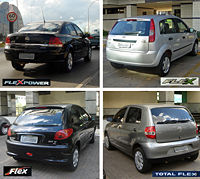
Brazilian flexible-fuel vehicle
Flexible-fuel vehicle
A flexible-fuel vehicle or dual-fuel vehicle is an alternative fuel vehicle with an internal combustion engine designed to run on more than one fuel, usually gasoline blended with either ethanol or methanol fuel, and both fuels are stored in the same common tank...
s are optimized to run on any mix of E20-E25 gasoline and up to 100% hydrous ethanol fuel (E100). Flex vehicles in Brazil are built-in with a small gasoline reservoir for cold starting the engine when temperatures drop below 15 °C (59 °F). An improved flex motor generation was launched in 2009 which eliminated the need for the secondary gas tank. According to two separate research studies conducted in 2009, 65% of the flex-fuel registered vehicles regularly use ethanol fuel
Ethanol fuel
Ethanol fuel is ethanol , the same type of alcohol found in alcoholic beverages. It is most often used as a motor fuel, mainly as a biofuel additive for gasoline. World ethanol production for transport fuel tripled between 2000 and 2007 from 17 billion to more than 52 billion litres...
, and use climbs to 93% of flex car owners in São Paulo
São Paulo (state)
São Paulo is a state in Brazil. It is the major industrial and economic powerhouse of the Brazilian economy. Named after Saint Paul, São Paulo has the largest population, industrial complex, and economic production in the country. It is the richest state in Brazil...
, the main ethanol producer state where local taxes are lower, and prices are more competitive than gasoline.
History
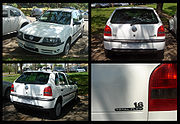
1973 oil crisis
The 1973 oil crisis started in October 1973, when the members of Organization of Arab Petroleum Exporting Countries or the OAPEC proclaimed an oil embargo. This was "in response to the U.S. decision to re-supply the Israeli military" during the Yom Kippur war. It lasted until March 1974. With the...
, the Brazilian government made mandatory the use of ethanol blends
Common ethanol fuel mixtures
There are several common ethanol fuel mixtures in use around the world. The use of pure hydrous or anhydrous ethanol in internal combustion engines is only possible if the engine is designed or modified for that purpose...
with gasoline, and neat ethanol-powered cars (E100 only) were launched to the market in 1979, after testing with several prototypes developed by four carmakers. Brazilian carmakers modified gasoline engines to support ethanol characteristics and changes included compression ratio
Compression ratio
The 'compression ratio' of an internal-combustion engine or external combustion engine is a value that represents the ratio of the volume of its combustion chamber from its largest capacity to its smallest capacity...
, amount of fuel injected, replacement of materials that would get corroded by the contact with ethanol, use of colder spark plugs suitable for dissipating heat due to higher flame temperatures, and an auxiliary cold-start system that injects gasoline from a small tank in the engine compartment to help starting when cold.
Flexible-fuel technology started being developed only by the end of the 1990s by Brazilian engineers and in March 2003 Volkswagen do Brasil
Volkswagen do Brasil
Volkswagen do Brasil Ltda. is a subsidiary arm of Volkswagen Group, established in 1953.-Brazilian developed Volkswagens:Many of its models were designed especially for Brazil:*Brasilia*SP1 & SP2*1500/Variant/Variant II*Karmann Ghia TC...
launched in the market the Gol
Volkswagen Gol
The Volkswagen Gol is a subcompact car manufactured by Volkswagen do Brasil since 1980 as Volkswagen's entry-level car in the South American market—where it succeeded the South American VW Beetle ...
1.6 Total Flex, the first commercial flexible fuel vehicle capable of running on any blend of gasoline and ethanol.
Technology
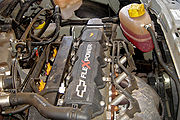
A key innovation in the Brazilian flex technology was avoiding the need for an additional dedicated sensor to monitor the ethanol-gasoline mix, which made the first American M85
M85
M85 or M-85 may refer to:* Messier 85, a lenticular galaxy in the constellation Coma Berenices* Zastava M85, an assault rifle developed and manufactured by Zastava Arms* M85 machine gun, a machine gun used in the M60 Patton series of tanks...
flex fuel vehicles too expensive. This was accomplished through the lambda probe
Oxygen sensor
An oxygen sensor, or lambda sensor, is an electronic device that measures the proportion of oxygen in the gas or liquid being analyzed. It was developed by the Robert Bosch GmbH company during the late 1960s under the supervision of Dr. Günter Bauman...
, used to measure the quality of combustion in conventional engines, is also required to tell the engine control unit
Engine control unit
An engine control unit is a type of electronic control unit that determines the amount of fuel, ignition timing and other parameters an internal combustion engine needs to keep running...
(ECU) which blend of gasoline and alcohol is being burned. This task is accomplished automatically through software developed by Brazilian engineers, called "Software Fuel Sensor" (SFS), fed with data from the standard sensors already built-in the vehicle. The technology was developed by the Brazilian subsidiary of Bosch
Robert Bosch GmbH
Robert Bosch GmbH is a multinational engineering and electronics company headquartered in Gerlingen, near Stuttgart, Germany. It is the world's largest supplier of automotive components...
in 1994, but was further improved and commercially implemented in 2003 by the Italian subsidiary of Magneti Marelli, located in Hortolândia
Hortolândia
Hortolândia is a municipality in the state of São Paulo in Brazil. The population in 2008 is 201 049 and the area is 62,2 km². The elevation is 587 m....
, São Paulo
São Paulo (state)
São Paulo is a state in Brazil. It is the major industrial and economic powerhouse of the Brazilian economy. Named after Saint Paul, São Paulo has the largest population, industrial complex, and economic production in the country. It is the richest state in Brazil...
. A similar fuel injection technology was developed by the Brazilian subsidiary of Delphi Automotive Systems
Delphi (auto parts)
Delphi Automotive PLC is an automotive parts company headquartered in Troy, Michigan, USA. Delphi is one of the world's largest automotive parts manufacturers and has approximately 146,600 employees ....
, and it is called "Multifuel", based on research conducted at its facility in Piracicaba
Piracicaba
Piracicaba is a city located in the Brazilian state of São Paulo. The population in 2009 was 368,843 in an area of 1,369.511 km², at an elevation of 547 m above sea level.-Name:...
, São Paulo. This technology allows the controller to regulate the amount of fuel injected and spark time, as fuel flow needs to be decreased and also self-combustion needs to be avoided when gasoline is used because ethanol engines have compression ratio around 12:1, too high for gasoline.
Brazilian flex engines are being designed with higher compression ratio
Compression ratio
The 'compression ratio' of an internal-combustion engine or external combustion engine is a value that represents the ratio of the volume of its combustion chamber from its largest capacity to its smallest capacity...
s, taking advantage of the higher ethanol blends and maximizing the benefits of the higher oxygen content of ethanol, resulting in lower emissions and improving fuel efficiency. The following table shows the evolution and improvement of the different generations of flex engines developed in Brazil.
| Comparison of performance of several generations of Brazilian flex-fuel engines (Percentages show change in performance as compared with using gasoline) |
|||||
|---|---|---|---|---|---|
| Year | Engine compression ratio Compression ratio The 'compression ratio' of an internal-combustion engine or external combustion engine is a value that represents the ratio of the volume of its combustion chamber from its largest capacity to its smallest capacity... |
Engine power |
Engine torque |
Fuel efficiency Fuel economy in automobiles Fuel usage in automobiles refers to the fuel efficiency relationship between distance traveled by an automobile and the amount of fuel consumed.... improvement |
Gasoline injection Fuel injection Fuel injection is a system for admitting fuel into an internal combustion engine. It has become the primary fuel delivery system used in automotive petrol engines, having almost completely replaced carburetors in the late 1980s.... cold start system |
| 2003 | 9.0:1 to 10.5:1 | +3% | +2% | -25 to -35% | Yes |
| 2006 | 11.0:1 to 12.5:1 | +7% | +5% | -25 to -30% | Yes |
| 2008 | 12.0:1 to 13.5:1 | +9% | +7% | -20 to -25% | No |
| Source: Joseph (2007) in The Royal Society (2008), "Sustainable biofuels: prospects and challenges". | |||||

Anhydrous
As a general term, a substance is said to be anhydrous if it contains no water. The way of achieving the anhydrous form differs from one substance to another...
ethanol, or on any arbitrary combination of both fuels. Pure gasoline is no longer sold in the country because these high ethanol blends are mandatory since 1993. Therefore, all Brazilian automakers have optimized flex vehicles to run with gasoline blends from E20 to E25, so these FFVs are unable to run smoothly with pure gasoline with the exception of two models are specifically built with a flex-fuel engine optimized to operate also with pure gasoline (E0), the Renault Clio Hi-Flex
Renault Clio
The Renault Clio is a supermini car produced by the French automobile manufacturer Renault. Originally launched in 1990, it is currently in its third generation...
and the Fiat Siena Tetrafuel
Fiat Siena
The Fiat Siena is the four-door sedan version of the Fiat Palio, a supermini car especially designed for developing countries. The car is similar to Fiat Albea...
.
The flexibility of Brazilian FFVs empowers the consumers to choose the fuel depending on current market prices. As ethanol fuel economy
Fuel economy in automobiles
Fuel usage in automobiles refers to the fuel efficiency relationship between distance traveled by an automobile and the amount of fuel consumed....
is lower than gasoline because of ethanol's energy content is close to 34% less per unit volume than gasoline, flex cars running on ethanol get a lower mileage than when running on pure gasoline. However, this effect is partially offset by the usually lower price per liter of ethanol fuel. As a rule of thumb
Rule of thumb
A rule of thumb is a principle with broad application that is not intended to be strictly accurate or reliable for every situation. It is an easily learned and easily applied procedure for approximately calculating or recalling some value, or for making some determination...
, Brazilian consumers are frequently advised by the media to use more alcohol than gasoline in their mix only when ethanol prices are 30% lower or more than gasoline, as ethanol price fluctuates heavily depending on the result of seasonal sugar cane harvests.
Production and market share
| Year | |Flex light trucks produced | |Flex vehicles as % total light vehicles(1)(2) | |Flex motor- cycles as % total |
|||
|---|---|---|---|---|---|---|
| 2003 | 39,853 | 9,411 | 49,264 | 2.9 | ||
| 2004 | 282,706 | 49,801 | 332,507 | 15.2 | ||
| 2005 | 776,164 | 81,735 | 857,899 | 36.1 | ||
| 2006 | 1,249,062 | 142,574 | 1,391,636 | 56.3 | ||
| 2007 | 1,719,745 | 217,186 | 1,936,931 | 69.1 | ||
| 2008 | 1,984,941 | 258,707 | 2,243,648 | 74.7 | ||
| 2009 | 2,241,820 | 299,333 | 2,541,153 | 84.0 | 188,494 | 12.2 |
| 2010 | 2,254,133 | 370,959 | 2,625,092 | 77.1 | 332,351 | 18.1 |
| 2011(CYTD) | n.a. | n.a. | 1,373,008 | 86.4 | 486,697 | 45.1 |
| Total 2003-10 | 10,548,424 | 1,429,706 | 11.978.130 | 57.1 | 520,845 | 23.9 |
| Total 2003-11 | 13,351,138 | 1,007,542 | ||||
| CYTD: calendar year to day as of June 2011. Sources: Cars and light trucks: ANFAVEA 2011, ANFAVEA 2010, and 2003 to 2009. Motorcycles: ABRACICLO 2009, 2010 and 2011. Notes: (1) Includes exports. (2) Total includes gasoline, neat ethanol, flex, and diesel-powered veh. |
||||||
After the market launch of the Gol
Volkswagen Gol
The Volkswagen Gol is a subcompact car manufactured by Volkswagen do Brasil since 1980 as Volkswagen's entry-level car in the South American market—where it succeeded the South American VW Beetle ...
1.6 Total Flex, the first commercial flexible fuel vehicle capable of running on any blend of gasoline and ethanol, GM do Brasil followed two months later with the Chevrolet Corsa 1.8 Flexpower, using an engine developed by a joint-venture with Fiat called PowerTrain. By 2010, twelve carmakers build flexible fuel vehicles, GM (Chevrolet), Fiat
Fiat
FIAT, an acronym for Fabbrica Italiana Automobili Torino , is an Italian automobile manufacturer, engine manufacturer, financial, and industrial group based in Turin in the Italian region of Piedmont. Fiat was founded in 1899 by a group of investors including Giovanni Agnelli...
, Ford, Peugeot
Peugeot
Peugeot is a major French car brand, part of PSA Peugeot Citroën, the second largest carmaker based in Europe.The family business that precedes the current Peugeot company was founded in 1810, and manufactured coffee mills and bicycles. On 20 November 1858, Emile Peugeot applied for the lion...
, Renault
Renault
Renault S.A. is a French automaker producing cars, vans, and in the past, autorail vehicles, trucks, tractors, vans and also buses/coaches. Its alliance with Nissan makes it the world's third largest automaker...
, Volkswagen
Volkswagen
Volkswagen is a German automobile manufacturer and is the original and biggest-selling marque of the Volkswagen Group, which now also owns the Audi, Bentley, Bugatti, Lamborghini, SEAT, and Škoda marques and the truck manufacturer Scania.Volkswagen means "people's car" in German, where it is...
, Honda
Honda
is a Japanese public multinational corporation primarily known as a manufacturer of automobiles and motorcycles.Honda has been the world's largest motorcycle manufacturer since 1959, as well as the world's largest manufacturer of internal combustion engines measured by volume, producing more than...
, Mitsubishi
Mitsubishi
The Mitsubishi Group , Mitsubishi Group of Companies, or Mitsubishi Companies is a Japanese multinational conglomerate company that consists of a range of autonomous businesses which share the Mitsubishi brand, trademark and legacy...
, Toyota, Citröen
Citroën
Citroën is a major French automobile manufacturer, part of the PSA Peugeot Citroën group.Founded in 1919 by French industrialist André-Gustave Citroën , Citroën was the first mass-production car company outside the USA and pioneered the modern concept of creating a sales and services network that...
, Nissan, and Kia Motors
Kia Motors
Kia Motors , headquartered in Seoul, is South Korea's second-largest automobile manufacturer, following the Hyundai Motor Company, with sales of over 1.4 million vehicles in 2010...
.
Flexible fuel vehicles were 22% of the new car sales in 2004, 73% in 2005, 87.6% in July 2008, and reached a record 94% in August 2009. The production of flex-fuel cars and light commercial vehicles since 2003 reached the milestone of 10 million vehicles in March 2010. As of December 2010, the fleet of flex automobiles and light commercial vehicles had reached almost 12 million vehicles, representing 17.4% of Brazil's motor vehicle fleet and 25.8% of all registered light vehicles.
The rapid success of flex vehicles was made possible by the existence of 33,000 filling stations with at least one ethanol pump available by 2006, a heritage of the early Pró-Álcool ethanol program. These facts, together with the mandatory use of E25
Common ethanol fuel mixtures
There are several common ethanol fuel mixtures in use around the world. The use of pure hydrous or anhydrous ethanol in internal combustion engines is only possible if the engine is designed or modified for that purpose...
blend of gasoline throughout the country, allowed Brazil in 2008 to achieve more than 50% of fuel consumption in the gasoline market from sugar cane-based ethanol.
According to two separate research studies conducted in 2009, at the national level 65% of the flex-fuel registered vehicles regularly use ethanol fuel, and use increases to 93% in São Paulo
São Paulo (state)
São Paulo is a state in Brazil. It is the major industrial and economic powerhouse of the Brazilian economy. Named after Saint Paul, São Paulo has the largest population, industrial complex, and economic production in the country. It is the richest state in Brazil...
, the main ethanol producer state where local taxes are lower, and E100 prices at the pump are usually more competitive than gasoline.
Flex-fuel motorcycles

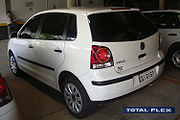
Honda
is a Japanese public multinational corporation primarily known as a manufacturer of automobiles and motorcycles.Honda has been the world's largest motorcycle manufacturer since 1959, as well as the world's largest manufacturer of internal combustion engines measured by volume, producing more than...
in March 2009. Produced by its Brazilian subsidiary Moto Honda da Amazônia, the CG 150 Titan Mix is sold for around .
Because the CG 150 Titan Mix does not have a secondary gas tank for a cold start like the Brazilian flex cars do, the tank must have at least 20% of gasoline to avoid start up problems at temperatures below 15 °C (59 °F). The motorcycle’s panel includes a gauge to warn the driver about the actual ethanol-gasoline mix in the storage tank. In September 2009, Honda launched a second flexible-fuel motorcycle, the on-off road NXR 150 Bros Mix. During the first eight months after its market launch the CG 150 Titan Mix sold 139,059 motorcycles, capturing a 10.6% market share
Market share
Market share is the percentage of a market accounted for by a specific entity. In a survey of nearly 200 senior marketing managers, 67 percent responded that they found the "dollar market share" metric very useful, while 61% found "unit market share" very useful.Marketers need to be able to...
, and ranking second in sales of new motorcycles in the Brazilian market by October 2009, and by year's end, both Honda flexible-fuel motorcycles sold a total of 183,375 units, representing a 11.4% market share of the Brazilian new motorcycle sales in that year. Cumulative sales of both flex fuel motorcycles reached 515,726 units in 2010, and sales in that year represented 18.15% of all motorcycle produced.
Two other flex-fuel motorcycles manufactured by Honda were launched in October 2010 and January 2011, the GC 150 FAN and the Honda BIZ 125 Flex. Cumulative production of the four available flex fuel models reached one million units in June 2011.
Next generation of flex engines
The Brazilian subsidiaries of Magneti Marelli, Delphi and Bosch have developed and announced the introduction in 2009 of a new flex engine generation that eliminates the need for the secondary gasoline tank by warming the ethanol fuel during starting, and allowing flex vehicles to do a normal cold start at temperatures as low as-5 °C, the lowest temperature expected anywhere in the Brazilian territory. Another improvement is the reduction of fuel consumption and tailpipe emissions, between 10% to 15% as compared to flex motors sold in 2008. In March 2009 Volkswagen do BrasilVolkswagen do Brasil
Volkswagen do Brasil Ltda. is a subsidiary arm of Volkswagen Group, established in 1953.-Brazilian developed Volkswagens:Many of its models were designed especially for Brazil:*Brasilia*SP1 & SP2*1500/Variant/Variant II*Karmann Ghia TC...
launched the Polo E-Flex
Volkswagen Polo
The Volkswagen Polo is a supermini car manufactured by Volkswagen. It is sold in Europe and other markets worldwide in hatchback, saloon, coupé and estate variants....
, the first flex fuel model without an auxiliary tank for cold start. The Flex Start system used by the Polo was developed by Bosch.
List of currently produced flexible-fuel vehicles
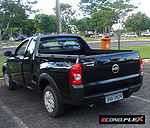
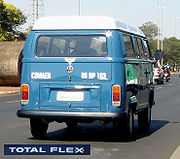
- ChevroletChevroletChevrolet , also known as Chevy , is a brand of vehicle produced by General Motors Company . Founded by Louis Chevrolet and ousted GM founder William C. Durant on November 3, 1911, General Motors acquired Chevrolet in 1918...
-
- Astra, BlazerChevrolet BlazerChevrolet Blazer can refer to one of several SUV models from General Motors:* The full-size Chevrolet K5 Blazer, based on the C/K pickup chassis and built from 1969 to 1994....
, CeltaChevrolet CeltaThe Chevrolet Celta is a low cost supermini produced by General Motors do Brasil for the Latin American market since 2000. 600,000 Celtas have been built in Gravataí, more than one hundred thousand per year. It is the second cheapest car sold in Brazil, losing only to the Fiat Mille...
, ClassicChevrolet ClassicGeneral Motors used the Chevrolet Classic nameplate for the following vehicles:* The second generation Chevrolet Corsa, produced in Brazil since 2002...
, Corsa, MontanaChevrolet MontanaThe Chevrolet Montana is a coupe utility sold by Chevrolet in Latin America and emerging markets. The design is a variation of the Opel Corsa, essentially a pickup version of the Opel Combo. In Mexico the vehicle is known as Chevrolet Tornado because of Pontiac using the Montana name for its...
, Meriva, Prisma, S10, Vectra, Zafira.- CitroënCitroënCitroën is a major French automobile manufacturer, part of the PSA Peugeot Citroën group.Founded in 1919 by French industrialist André-Gustave Citroën , Citroën was the first mass-production car company outside the USA and pioneered the modern concept of creating a sales and services network that...
- Citroën
- C3Citroën C3The Citroën C3 is a supermini car equipped with a range of inline-four engines that has been produced by the French automaker Citroën since 2002. It was designed by Donato Coco and Jean-Pierre Ploué, previously known for designing the first generation Renault Twingo; the former has been the head of...
, C4, C4 PallasCitroën C4The Citroën C4 is a small family car produced by French automaker Citroën since autumn 2004. The C4 was designed to be the successor to the Citroën Xsara. It is mechanically similar to the Peugeot 308, which was launched in 2007. A revised version with new front end, reverse light and dashboard...
, Xsara PicassoCitroën Xsara PicassoThe Citroën Xsara Picasso is a compact MPV released by Citroën in 1999. At the time of its release, two trim levels were available, LX and SX, with a choice of three engines two 1.6 and 1.8 litre petrols, and a 2.0 Litre HDI engine, all shared with the smaller Citroën Xsara. The Executive trim...
.- FiatFiatFIAT, an acronym for Fabbrica Italiana Automobili Torino , is an Italian automobile manufacturer, engine manufacturer, financial, and industrial group based in Turin in the Italian region of Piedmont. Fiat was founded in 1899 by a group of investors including Giovanni Agnelli...
- Fiat
- DoblòFiat DoblòThe Fiat Doblò is a panel van and leisure activity vehicle produced by Italian automaker Fiat since 2000, it was unveiled at the Paris Motor Show in 2000.-First generation :...
, LineaFiat LineaThe Fiat Linea is a small family car released on March 26, 2007 at Tofaş plant in Bursa, Turkey, by the Italian automaker Fiat as a world car in developing countries. It replaced the aging Marea as the largest saloon in the Fiat range. It is based on the current Fiat Grande Punto platform...
, IdeaFiat IdeaThe Fiat Idea is a mini MPV built by the Italian manufacturer Fiat since 2003. The car is based on the Project 188 platform, originally used for the second-generation Fiat Punto. The Idea is noted for its versatile interior, which includes sliding and folding rear seats...
, Mille, Palio, Palio FireFiat PalioThe Fiat Palio is a small family car designed by Fiat as a world car, aimed at developing countries. It is produced in Brazil, Argentina, Turkey, South Africa and China. It is also built under licence in North Korea as the Pyonghwa Hwiparam. Russian ZMA started assembly of Turkish CKD kits in...
, Palio Weekend, PuntoFiat PuntoThe Fiat Punto is a supermini produced by the Italian manufacturer, Fiat, since 1993.-1st generation :Internally codenamed Project 176, the Punto was announced in September 1993 and launched in late 1993 as a replacement for the ageing Fiat Uno. The Fiat Punto was voted European Car of the Year...
, SienaFiat SienaThe Fiat Siena is the four-door sedan version of the Fiat Palio, a supermini car especially designed for developing countries. The car is similar to Fiat Albea...
, StiloFiat StiloThe Fiat Stilo is a small family car available as a 3-door and a 5-door hatchback, as well as an estate , produced by the Italian automaker Fiat Automobiles. The Stilo 3-door and 5-door were launched in 2001 to replace the Fiat Bravo/Brava, with the Stilo MultiWagon following in 2002...
, StradaFiat StradaThe Fiat Strada is a supermini coupé utility version of Fiat's "world car" project, the Palio. It is produced in Brazil and exported from Betim, Minas Gerais to the European Union.-History:...
, UnoFiat UnoThe Fiat Uno is a supermini car produced by the Italian manufacturer Fiat. The Uno was launched in 1983 and built in its homeland until 1995, with production still taking place in other countries.-First series :...
.- FordFord Motor CompanyFord Motor Company is an American multinational automaker based in Dearborn, Michigan, a suburb of Detroit. The automaker was founded by Henry Ford and incorporated on June 16, 1903. In addition to the Ford and Lincoln brands, Ford also owns a small stake in Mazda in Japan and Aston Martin in the UK...
- Ford
- CourierFord Courier- North America :This was a commercial model based on Ford's full-size stationwagon line. Its model code was designated 78A.From 1952 to 1956 access to the rear storage area was through a unique door hinged on the side. For 1957 and 1958, the rear access door was a combination of the lift gate and...
, EcoSportFord EcoSportThe Ford EcoSport is a mini SUV designed by the Ford-US Truck Vehicle Center and built in Brazil by Ford. The EcoSport is one of Ford's best-seller models in Brazil, Argentina, Venezuela and Mexico...
, FiestaFord FiestaThe Ford Fiesta is a front wheel drive supermini/subcompact manufactured and marketed by Ford Motor Company and built in Europe, Brazil, Argentina, Mexico, Venezuela, China, India, Thailand and South Africa...
, Focus, KaFord KaThe Ford Ka is a city car from the Ford Motor Company marketed in Europe and elsewhere.The current European version is produced by Fiat Auto in Tychy, Poland, while the model sold in Latin America is built in Brazil and Argentina....
.- HondaHondais a Japanese public multinational corporation primarily known as a manufacturer of automobiles and motorcycles.Honda has been the world's largest motorcycle manufacturer since 1959, as well as the world's largest manufacturer of internal combustion engines measured by volume, producing more than...
- Honda
- City, CivicHonda CivicThe Honda Civic is a line of subcompact and subsequently compact cars made and manufactured by Honda. The Civic, along with the Accord and Prelude, comprised Honda's vehicles sold in North America until the 1990s, when the model lineup was expanded...
, FitHonda FitThe Honda Jazz is a five-door hatchback subcompact manufactured by the Honda Motor Company of Japan, first introduced in June 2001 and is now in its second generation. The Jazz shares Honda's Global Small Car Platform with the City/Fit Aria, Airwave/Partner, Mobilio, Mobilio Spike, Freed and Freed...
, and four motorcycles CG Titan Mix, NXR 150 Bros Mix, GC 150 Fan Flex and the BIZ 125 Flex.- Kia MotorsKia MotorsKia Motors , headquartered in Seoul, is South Korea's second-largest automobile manufacturer, following the Hyundai Motor Company, with sales of over 1.4 million vehicles in 2010...
- Kia Motors
- Kia SoulKia SoulThe Kia Soul is a compact car designed at Kia's design center in California, unveiled at the 2008 Paris Motor Show, manufactured in South Korea and marketed globally beginning with model year 2010....
- MitsubishiMitsubishiThe Mitsubishi Group , Mitsubishi Group of Companies, or Mitsubishi Companies is a Japanese multinational conglomerate company that consists of a range of autonomous businesses which share the Mitsubishi brand, trademark and legacy...
- Mitsubishi
- Pajero TR4, Pajero Sport, Pajero L200 TritonMitsubishi TritonThe Mitsubishi Triton is a compact pickup truck produced by Mitsubishi Motors. It was originally known as the Mitsubishi Forte in Japan from 1978 to 1986, when the name was discontinued in favour of the Strada. In the United States two captive imports of the Forte were sold by the Chrysler...
,- Nissan
- Livina, SentraNissan SentraThe Nissan Sentra is a compact car produced by automaker Nissan Motors and is generally a rebadged export version of the Japanese Nissan Sunny. The name "Sentra" is not used in Japan....
, TiidaNissan TiidaThe Nissan Tiida is a compact car, manufactured by Japanese automaker Nissan, replacing the Pulsar and the Sunny, and marketed also as the Nissan Versa, prominently in the United States...
- PeugeotPeugeotPeugeot is a major French car brand, part of PSA Peugeot Citroën, the second largest carmaker based in Europe.The family business that precedes the current Peugeot company was founded in 1810, and manufactured coffee mills and bicycles. On 20 November 1858, Emile Peugeot applied for the lion...
- Peugeot
- 206Peugeot 206The Peugeot 206 is a supermini car, manufactured by the French automaker Peugeot from 1998 to 2010.Even though the 206 has finished production in most markets as of 2010, in Europe since 2009, it is available the 206+, with a back and especially a front design that resembles the Peugeot 207.-The...
, 307Peugeot 307The Peugeot 307 is a small family car produced by the French Peugeot manufacturer since 2001. It was awarded the European Car of the Year title for 2002, and continues to be offered in China and certain South American markets through 2009 despite the French launch of the 308 in September...
- RenaultRenaultRenault S.A. is a French automaker producing cars, vans, and in the past, autorail vehicles, trucks, tractors, vans and also buses/coaches. Its alliance with Nissan makes it the world's third largest automaker...
- Renault
- ClioRenault ClioThe Renault Clio is a supermini car produced by the French automobile manufacturer Renault. Originally launched in 1990, it is currently in its third generation...
, KangooRenault KangooThe Renault Kangoo and Kangoo Express are panel van and leisure activity vehicle produced by French automaker Renault since 1997. The Kangoo is manufactured in the MCA plant in Maubeuge, France, and in Santa Isabel, Argentina. The version for the ASEAN markets was assembled by the Tan Chong Euro...
, Grand Tour, MéganeRenault MéganeThe Renault Mégane is a small family car produced by the French automaker Renault since 1995. It is offered in 3- and 5-door hatchback, saloon, coupé, convertible and estate bodystyles...
, ScénicRenault ScénicThe Renault Scénic is a compact MPV produced by French automaker Renault, the first to be labelled as such in Europe. It is based on the chassis of the Mégane small family car. It became 1997 European Car of the Year on its launch in late 1996...
, Logan, Sandero, SymbolRenault SymbolThe Renault Symbol, or Thalia in some markets, is a sedan car produced by the French automobile manufacturer Renault. The first generation was introduced as the saloon version of the second generation Renault Clio, but was marketed only in those countries where the hatchback didn't sell too well,...
.- Toyota
- Toyota CorollaToyota CorollaThe Toyota Corolla is a line of subcompact and compact cars manufactured by the Japanese automaker Toyota, which has become very popular throughout the world since the nameplate was first introduced in 1966. In 1997, the Corolla became the best selling nameplate in the world, with over 35 million...
- VolkswagenVolkswagenVolkswagen is a German automobile manufacturer and is the original and biggest-selling marque of the Volkswagen Group, which now also owns the Audi, Bentley, Bugatti, Lamborghini, SEAT, and Škoda marques and the truck manufacturer Scania.Volkswagen means "people's car" in German, where it is...
- Volkswagen
- Bora, CrossFox, FoxVolkswagen FoxThe Volkswagen CrossFox is a mini SUV version which sets it apart from the standard Fox. As is the case for other similar models, it is available only with front-wheel drive....
, GolVolkswagen GolThe Volkswagen Gol is a subcompact car manufactured by Volkswagen do Brasil since 1980 as Volkswagen's entry-level car in the South American market—where it succeeded the South American VW Beetle ...
, GolfVolkswagen GolfThe Volkswagen Golf is a small family car manufactured by Volkswagen since 1974 and marketed worldwide across six generations, in various body configurations and under various nameplates – as the Volkswagen Rabbit in the United States and Canada , and as the Volkswagen Caribe in Mexico .The...
, KombiVolkswagen Type 2The Volkswagen Type 2, officially known as the Transporter or Kombi informally as Bus or Camper , was a panel van introduced in 1950 by German automaker Volkswagen as its second car model – following and initially deriving from Volkswagen's first model, the Type 1 , it was given the factory...
, ParatiVolkswagen GolThe Volkswagen Gol is a subcompact car manufactured by Volkswagen do Brasil since 1980 as Volkswagen's entry-level car in the South American market—where it succeeded the South American VW Beetle ...
, PoloVolkswagen PoloThe Volkswagen Polo is a supermini car manufactured by Volkswagen. It is sold in Europe and other markets worldwide in hatchback, saloon, coupé and estate variants....
, SaveiroVolkswagen GolThe Volkswagen Gol is a subcompact car manufactured by Volkswagen do Brasil since 1980 as Volkswagen's entry-level car in the South American market—where it succeeded the South American VW Beetle ...
, SpaceFox, Voyage.
- Astra, Blazer
See also
- Alternative fuel vehicleAlternative fuel vehicleAn alternative fuel vehicle is a vehicle that runs on a fuel other than "traditional" petroleum fuels ; and also refers to any technology of powering an engine that does not involve solely petroleum...
- Ethanol fuel in BrazilEthanol fuel in BrazilBrazil is the world's second largest producer of ethanol fuel and the world's largest exporter. Together, Brazil and the United States lead the industrial production of ethanol fuel, accounting together for 87.8% of the world's production in 2010. In 2010 Brazil produced 26.2 billion litres Brazil...
- Flexible-fuel vehicles in the United StatesFlexible-fuel vehicles in the United StatesFlexible-fuel vehicles in the United States are the second largest flex-fuel fleet in the world after Brazil, and as of December 2009 there were 8.3 million flex-fuel cars and light trucks in operation...
- List of flexible-fuel vehicles by car manufacturer

